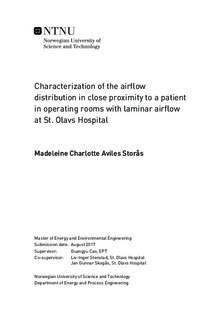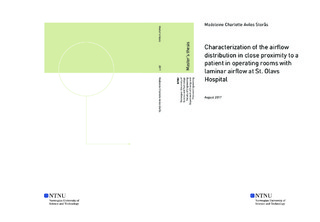| dc.description.abstract | This master's thesis has investigated the airflow distribution in close proximity to a patient in a laminar airflow ventilated operating theatre. The assignment was divided into three different scenarios, that each consider an important aspect in the assignment. Scenario 1 considers the effect that warm surfaces close to an operating table has on the air distribution above the table. A thermal manikin was used to study thermal plume generated by both natural and forced convection. In Scenario 2 the plume above a thermal manikin is studied in a non-ventilated room and in Scenario 3 the interaction between a thermal plume generated by a patient and the laminar airflow ventilation system is investigated. All of the scenarios were investigated experimentally, and the majority of the results are presented as contour plots.
First it was investigated whether the airflow from the ceiling, laminar air supply diffuser was affected by the presence of warm surfaces around the operating table. Three heated cylinders and two surgical lamps were placed around the table and several different cases were studied. The obtained result was that the convective airflow had an impact on the air distribution above the operating table. The surgical lamps had the greatest impact on the air distribution above the table, as their placement between the air supply diffuser and the table hindered the airflow to reach the operating table. Lamps placed in horizontal position was discovered to block the airflow the most. The addition of surgical lamps also increased the turbulence level above the table to a much higher level. This indicate that the placement of the lamps above the surgical zone should be considered carefully before an operation. The first scenario did also show that the addition of thermal plumes can cause larger local temperature gradients and higher local air speeds above the operating table.
Velocity profiles above a thermal manikin in a non-ventilated room were obtained. The purpose of this was to investigate the potential the thermal plume has on the air distribution in a room. The experiment showed that the greatest plume was developed above the manikin's stomach, and the maximum velocity was 0.139 m/s. By the measured velocity profile above the stomach, two different approaches were used to suggest a mathematical equation for the plume development, and it was suggested to be modeled as a point source.
Lastly, the interaction between a thermal plume from a patient and clean airflow from the supply diffuser was investigated. It was shown that the convective airflow from the thermal manikin had an impact on the airflow from the ventilation system, which also was concluded by measurements performed on above a real human. This indicates that the human thermal plume should be considered when designing laminar airflow ventilation systems.
Several limitations made it challenging to solve the main objective of the master's thesis, and the conclusions from the experiments should therefore be looked deeper into. However, some observations were done that hopefully will contribute to the lack of previous studies on the field. The thesis does also give some observations that can be considered for design of ventilation systems. | |

